第二语言习得理论及应用论文
二语习得论文

浅论Krashen的二语习得理论摘要:Krashen 提出的二语习得理论由五个假说组成:语言习得与学习假说,监察假说,自然顺序假说,语言输入假说,情感过渡假说。
这些假说对教学实践有一定的指导意义,但同时也存在一定的局限性:忽视了习得过程的输出环节;在实际教学中缺乏可操作性。
关键词:语言习得与学习假说; 监察假说;自然顺序假说; 语言输入假说; 情感过渡假说Abstract:Krashen's second language acquisition theories consists of five main hypotheses: the acquisition and learning hypothesis, monitor hypothesis, the natural order hypothesis, the input hypothesis, affective transition hypothesis. This hypothesis has certain directive significance to the teaching practice, but also has some limitations: ignore the output acquisition process; lack of operability in actual teaching in some degree.Keywords: acquisition & learning hypothesis;monitor hypothesis;natural order hypothesis;input hypothesis;filter hypothesis正文:一.前言美国语言学家Krashen在上世纪80年代初提出了著名的二语习得理论——“监察理论”。
这一理论自提出之日起就引起了语言学家的广泛关注,对外语教学产生了很大影响。
探析二语习得理论在英语教学中的运用
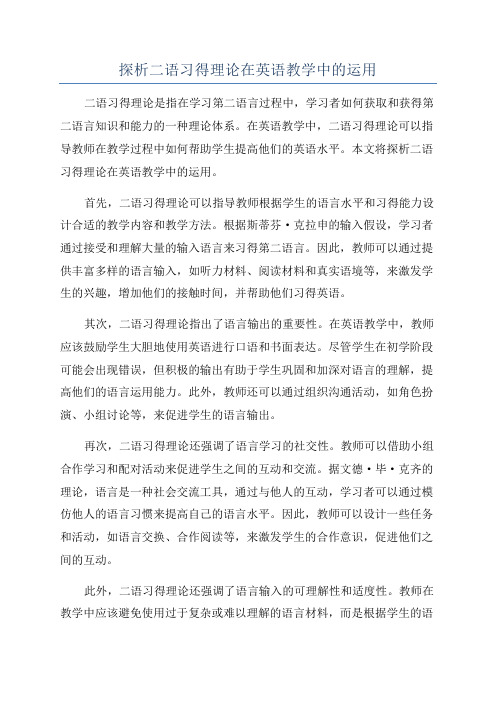
探析二语习得理论在英语教学中的运用二语习得理论是指在学习第二语言过程中,学习者如何获取和获得第二语言知识和能力的一种理论体系。
在英语教学中,二语习得理论可以指导教师在教学过程中如何帮助学生提高他们的英语水平。
本文将探析二语习得理论在英语教学中的运用。
首先,二语习得理论可以指导教师根据学生的语言水平和习得能力设计合适的教学内容和教学方法。
根据斯蒂芬·克拉申的输入假设,学习者通过接受和理解大量的输入语言来习得第二语言。
因此,教师可以通过提供丰富多样的语言输入,如听力材料、阅读材料和真实语境等,来激发学生的兴趣,增加他们的接触时间,并帮助他们习得英语。
其次,二语习得理论指出了语言输出的重要性。
在英语教学中,教师应该鼓励学生大胆地使用英语进行口语和书面表达。
尽管学生在初学阶段可能会出现错误,但积极的输出有助于学生巩固和加深对语言的理解,提高他们的语言运用能力。
此外,教师还可以通过组织沟通活动,如角色扮演、小组讨论等,来促进学生的语言输出。
再次,二语习得理论还强调了语言学习的社交性。
教师可以借助小组合作学习和配对活动来促进学生之间的互动和交流。
据文德·毕·克齐的理论,语言是一种社会交流工具,通过与他人的互动,学习者可以通过模仿他人的语言习惯来提高自己的语言水平。
因此,教师可以设计一些任务和活动,如语言交换、合作阅读等,来激发学生的合作意识,促进他们之间的互动。
此外,二语习得理论还强调了语言输入的可理解性和适度性。
教师在教学中应该避免使用过于复杂或难以理解的语言材料,而是根据学生的语言水平和学习需求选择合适的材料。
同时,教师还可以通过提供适当的文化背景知识和语言学习策略来帮助学生更好地理解英语,提高他们的语言运用能力。
最后,二语习得理论还提出了错误处理的重要性。
学习者在第二语言习得过程中不可避免地会出现错误,教师应该正确处理这些错误,帮助学生纠正和改进。
教师可以通过及时反馈、错误纠正和语言意识提高的活动来帮助学生修正错误,培养他们的语言敏感性和自我纠正能力。
第二语言习得理论及应用论文
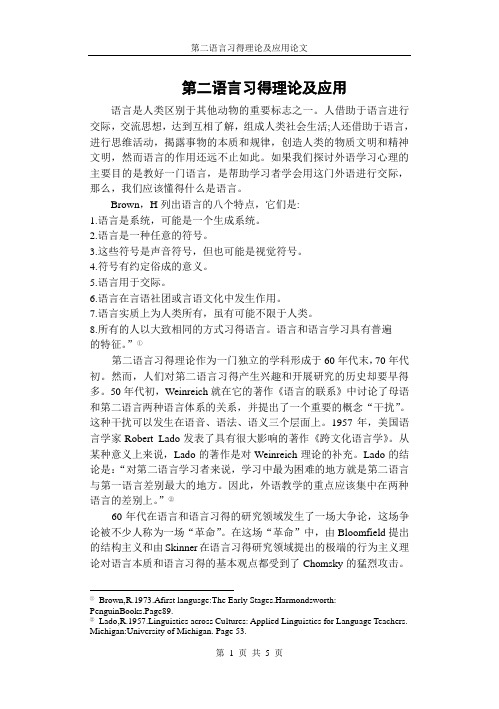
第二语言习得理论及应用语言是人类区别于其他动物的重要标志之一。
人借助于语言进行交际,交流思想,达到互相了解,组成人类社会生活;人还借助于语言,进行思维活动,揭露事物的本质和规律,创造人类的物质文明和精神文明,然而语言的作用还远不止如此。
如果我们探讨外语学习心理的主要目的是教好一门语言,是帮助学习者学会用这门外语进行交际,那么,我们应该懂得什么是语言。
Brown,H列出语言的八个特点,它们是:1.语言是系统,可能是一个生成系统。
2.语言是一种任意的符号。
3.这些符号是声音符号,但也可能是视觉符号。
4.符号有约定俗成的意义。
5.语言用于交际。
6.语言在言语社团或言语文化中发生作用。
7.语言实质上为人类所有,虽有可能不限于人类。
8.所有的人以大致相同的方式习得语言。
语言和语言学习具有普遍的特征。
”①第二语言习得理论作为一门独立的学科形成于60年代末,70年代初。
然而,人们对第二语言习得产生兴趣和开展研究的历史却要早得多。
50年代初,Weinreich就在它的著作《语言的联系》中讨论了母语和第二语言两种语言体系的关系,并提出了一个重要的概念“干扰”。
这种干扰可以发生在语音、语法、语义三个层面上。
1957年,美国语言学家Robert Lado发表了具有很大影响的著作《跨文化语言学》。
从某种意义上来说,Lado的著作是对Weinreich理论的补充。
Lado的结论是:“对第二语言学习者来说,学习中最为困难的地方就是第二语言与第一语言差别最大的地方。
因此,外语教学的重点应该集中在两种语言的差别上。
”②60年代在语言和语言习得的研究领域发生了一场大争论,这场争论被不少人称为一场“革命”。
在这场“革命”中,由Bloomfield提出的结构主义和由Skinner在语言习得研究领域提出的极端的行为主义理论对语言本质和语言习得的基本观点都受到了Chomsky的猛烈攻击。
①Brown,R.1973.Afirst langusge:The Early Stages.Harmondsworth: PenguinBooks.Page89.②Lado,R.1957.Linguistics across Cultures: Applied Linguistics for Language Teachers. Miehigan:University of Miehigan. Page 53.争论过后,人们开始认识到一个事实,那就是语言是一种特殊的体系,要了解这一体系的发展过程,我们不能单纯的从外界的因素中去寻找答案,它有它自己的内在发展规律。
二语习得论文

College of Foreign Languages and LiteratureNorthwest Normal University题目:Motivation and Second Language Acquisition 班级:12级英语5班姓名:王文秀任课教师:曹依民提交日期:2015年7月3日评语及成绩:签名:日期:Motivation and Second Language Acquisition摘要在对第二语言学习的研究中,学习动机被认为是语言学习者个体因素中最具能动性的因素之一,它受到了众多研究者和教育工作者的关注。
随着全球化的发展,第二语言的重要性显而易见。
这就要求我们要深入研究了解动机与第二语言学习。
本文将从理论和实际应用的角度研究第二语言习得中的动机问题。
本文先从学习动机的定义出发阐述不同语言学家对动机不同角度的定义,包括被语言学家公认为合理的由Gardner & Lambert所下的定义,以及从人本主义角度出发的马斯洛的需求理论中对动机的定义,从而发现这些定义的局限性。
在阐述定义的基础上,文章从行为主义、人本主义及认知角度分别运用强化理论、需求理论及归因理论来研究及分析动机,说明对第二语言研究的意义。
随后采用语言学家Keller对影响学习动机的四大主要因素的划分,从兴趣、相关性、期待及对结果的满意度简要阐述影响学习的因素及其影响。
本文旨在帮助第二语言学习者意识到动机在二语习得的重要性。
关键字:动机,第二语言习得,定义,影响因素AbstractMotivation is one of the important affective factors widely studied on the second language acquisition by language learning researchers in the past years. With the development of globalization, the importance of the second language acquisition is obvious. So it is necessary for us to profound motivation and second language acquisition.This paper will research motivation in the second language acquisition from the theory to application, beginning with its different definitions given by different linguists on the base of various theories. It includes the well-accepted definition given by Gardner & Lambert, popular one defined by Maslow from humanistic perspective and other definitions proposed respectively by different linguists. In the process, the limitation of these definitions will be found. Then, the thesis focuses on the study and analysis of motivations from behavioral, humanistic and cognitive perspectives with the application of reinforcement theory, need theory and attribution theory to prove the significance of researching second language acquisition. Then, the author analyses affecting motivation factors,including interest, relevance, expectance and satisfaction or outcomes, which are divided by linguist Keller. This paper aims to help language learners realize theimportance of motivation in the second language acquisition.Key words: motivation, second language acquisition, definition, affecting factors1. IntroductionMotivation plays a vital role in the foreign language acquisition. A lot of linguists and psychologists believe motivation is one factor affecting language learning efficacy, the impulse stimulating persons to conduct certain activities, a kind of inner power promoting foreign language learning, and a type of conscious and positive state of psychology in learning activity. Regarded as one important element in language learning, motivation has been explored for more than fifty years by a lot of linguists, but the awkward situation still exists in present language learning setting. Many experts have done a lot of research around it and made contributions to it.With the development of globalization, the importance of the second language acquisition is obvious. So it is necessary for us to profound motivation and second language acquisition. This paper aims to explore and analyses language learning motivation from different perspectives: behaviorism, humanism and cognition, making reference to various classifications and definitions of motivation.The thesis is made up of six parts besides an introduction, a conclusion and a bibliography. Part two is literature review. Part three presents some basic theories in motivation. In this part, behaviorism, humanism and cognition are discussed. Part four is analysis of factors affecting motivation in detail. It consists of interest, relevance, expectance and satisfaction or outcomes.This paper pays attention on three questions:1.What is the definition of motivation?2.What are factors affecting motivation?3.How does the motivation affect second language acquisition?2. Literature reviewAlthough the term "motivation" is frequently used in education contexts, there is little agreement among experts as to its exact meaning. Various definitions of motivation have been proposed over the course of decades of research. What we concern about motivation is mainly confined to EFL study, so we should put our emphasis on specific category.From the middle of 20th century, especially around 1990s, new definitions appeared with the developments in psychology. Motivation was then redefined as a dynamic process rather than astatic inner state. However, there is still disagreement about the definition of motivation.2.1 Definitions of MotivationMotivation is one of the main determinants of second language learning achievement and, accordingly, the last three decades have seen a considerable amount of research investigating the nature and role of motivation in the L2 learning process. Much of this research has been initiated and inspired by two Canadian psychologists, Robert Gardner and Wallace Lambert, who, together with their colleagues and students, grounded motivation research in a social psychological framework.2.1.1 Gardner's DefinitionIt's the fact that Gardner's definition of motivation in Second Language Acquisition (SLA) is the best known, frequently-quoted and under revision with the time passing. Gardner and Lambert (1972) define ‘motivation’ in terms of the L2 learner’s overall goal or orientation. Gardner also proposed that all these three components were necessary to properly describe motivation in language learning. Any single one of them cannot reflect true motivation, so they must co-exist with each other.Eight years later, Gardner and Maclntyre (1993) defined motivation as "the desire to achieve a goal, effort extended in this direction and satisfaction with the task." Gardner's definition is based on social psychology stressing the social nature of L2 learning. In his view, apart from learning grammar and language skills, the learning of an L2 involves an alteration in self-image, the adoption of new social and cultural behaviors which have a significant impact on the social nature of the learner. As we know, Gardner and his colleagues' researches are conducted among typically bilingual setting---Canada, where learners' language learning is greatly influenced by the learners' attitude towards the target language, therefore there is inevitable limitations existing in this definition by nature. Besides its shortcomings, Gardner and his colleagues had made great contributions to the motivation research in the late 1980s; other theorists began to challenge his theory and re-conceptualize the construct of L2 learning motivation.2.1.2 Brown’s DefinitionBrown (1981) identifies three types of motivation: (1) global motivation, which consists of a general orientation to the goal of learning a L2; (2) situational motivation, which varies according to the situation in which learning takes place (the motivation associated with classroom learning is distinct from the motivation involved in naturalistic learning); (3) task motivation, which is themotivation for performing particular learning tasks.2.1.3Williams and Burden's DefinitionWilliams and Burden (1997) defined motivation as "a state of cognitive and emotional arousal, which leads to a conscious decision to act, and which gives rise to a period of sustained intellectual and/or physical effort, in order to attain a previously set goal or goals.” In order to make this definition more clearly, Williams and Burden (1997) presented a three-stage model of interactive factors within the social context: reasons for doing something----deciding to do something---sustaining the effort or persisting.From this model, we can see that firstly there must be some reasons to impel learners to undertake a particular activity; secondly, we should consider what is actually involved in deciding to do something and an individual may have strong reasons for doing something but without taking actual action; thirdly, people need to sustain the effort required to complete the activity. In this model, "deciding to do something" plays a central role.2.1.4 Maslow's DefinitionAccording to Maslow, "motivation is constant, never ending, fluctuating and complex, and it is an almost universal characteristic of particularly every organic state of affairs.” And his "need theory" can clearly and satisfactorily explain the language learners' motivation in all the learning environments. The need hierarchy is as follows (S.S.Chauhan, 1985):2.1. 5 Dornyei and Otto's DefinitionDornyei and Otto (1998) stated that "in a general sense, motivation can be defined as the dynamically changing initiates, directs, coordinates, amplifies, cumulative arousal in a person thatterminates and evaluates the cognitive processes whereby initial wishes and desires are selected, prioritized, operationalized and successfully or unsuccessfully acted out" In this definition, motivation is viewed as a dynamic process in which many variables influence the learner's performance but they do not mention the sustaining of the learning motivation.2.1. 6 Keller's DefinitionKeller (1983) defined motivation as "Motivation refers to the choices people make as to what experiences or goals they will approach or avoid, and the degree of effort they will exert in this respect."Besides definitions given above, Kanfer and Ackerman (1989) made it more explicit by defining motivation as "the direction of attentional effort, the proportion of total attentional effort directed to the task (intensity), and the extent to which attentional effort toward the task is maintained over time (or persistence)." Oxford defined motivation as "what makes students want to learn languages and what causes them to put forth the effort to persist in this difficult adventure" (Oxford, 1996, p. 1). According to H.W Bernard, "motivation refers to all those phenomena which are involved in the stimulation of action towards particular objectives where previously there was little or no movement towards those goals."In view of all these definitions, we can get the information that language learning motivation is the reason for learning the language, the central force or inner power that impulses people to go in the language learning process, how much conscious intellectual and physical effort the learners make to attain a previously set goal and how long the learner keeps this effort.3. Theories on MotivationMotivation is a vast and complicated subject with many theories in educational psychology. The main approaches are behavioral, humanistic and cognitive ones, which highlight different dimensions of motivation. However, there is no absolutely, straightforwardly and unanimously accepted concept of motivation, let alone the description of its nature within one framework. Different from the instinct theory studying the innate characteristics of motivation born in human beings, the behaviorism attaches more importance to the external factors for the study of motivation.3.1 BehaviorismBehaviorism, a theory about animal and human learning way which only focuses onobjectively observable behaviors and discounts mental activities, has an important impact on psychology, education and language teaching.Behaviorists like Skinner take the notion that behavior is a function of its consequences, so the learners will repeat the desired behavior if positive reinforcement (a pleasant consequence) follow the behavior. Behaviorists prefer to explain human behaviors with formula S---R, believing motivation is a kind of impulsive force aroused by outside stimuli. According to Skinner, motivated behavior results from the consequences of the similar previous behavior and in other words, the consequences of previous behavior influence learners. Once learners obtain positive reinforcement for certain behavior, they tend to repeat it with vigor, vice versa learners tend to lose interest, and evade their performance and study.Behavioral interpretations of learning can provide reasons to explain why some learners react favorably to particular subjects but dislike others. Some learners may enter a classroom with a feeling of delight, while others feel uncomfortable or aversive to it. B.F.Skinner suggested that such differences could be traced back to their previous experiences, arguing that the learner who loved this subject had been shaped to respond that way by a series of positive experiences with the subject while the learner disliking the subject might have suffered a series of negative experiences.In brief, reinforcement methods are probably best used with learners who exhibit high anxiety about learning, poor motivation to learn, or a history of academic failures. And it is effective methods frequently used by teachers in classroom setting.3.2 HumanismMotivation and needs are closely related. On the one hand, we regard motivation as the fulfillment of a kind of needs, and on the other hand, human needs serve as drives or incentives which impulse one to take an action.When we study motivation from the perspective of humanism, it is necessary to mention hierarchy of needs proposed by Maslow. He formulated a five-fold hierarchy of human needs which began with biological needs and made progress upward to the self-actualization. According to Maslow, "motivation is constant, never ending, fluctuating and complex and that it is an almost universal characteristic of particularly every organic state of affairs." His need theory can clearly and satisfactorily explain the language learners' motivation in all learning environments. The need hierarchy is as follows (S.S.Chauhan, 1985):Although Maslow's theory has been confronted with a number of critiques and contradictions, it provides a useful way of thinking about the factors that activate human action. In terms of Maslow's needs hierarchy,needs for foreign or second language learning would mainly center on the psychological aspects of the second level in the hierarchy and, when those needs are satisfied, would relate to the third, fourth, and fifth levels in the pyramid. Additionally, as the needs at one level are met, their importance in motivating individual decreases, and the next higher level of needs becomes the strongest source of goal-directed behaviors.In view of Maslow's need hierarchy,failure to satisfy students' needs for safety and security in the foreign or second language learning setting probably hinder their risk-taking, accordingly, these psychological insecurity will make L2 learners very anxious ( MacItyre & Gardner, 1991) and they will regress in their needs, motivation, and performance in the classroom.3.3 CognitionAs its name implies, cognitive approach, emphasizing mental processes places itself in processes. Since the 1960s, the mechanistic approach to human motivation has given way to a more cognitive approach. The common element shared by particular cognitive theorists is the belief that it is necessary to examine a class of intervening variables when explaining behavior. The theoretical foundation of a cognitive approach can be traced to the writings of Kant (31) and to phenomenological thinking. Uan de Geer and Jaspers note that cognitive theory ranges from neobehavioristic mediation to phenomenological interpretation.A cognitive theory of behavior assumes that the first stage in the chain of events initiated bythe stimulus situation and resulted in the behavioral act is the construction of cognitive representation of the distal environment. The later events in the chain are aroused, modified and guided by this cognitive representation. The cognitive representation thus acts as the effective environment which arouses motives and emotions, and guides overt behavior toward its target or goal.The famous theory annotating motivation is attribution theory. People, after finishing one task, are likely to look for the reason why he can succeed or suffer failure, which is the first objective base, on which psychologist attribution. F. Heider, the one proposing attribution theory, believed explore people possessed two needs of understanding world and controlling environment. Ability and effort are internal characteristics; task difficulty and luck belong to external factors; task difficulty and ability are stable factors, whereas effort and luck change with variable situations. According to attribution theory, higher satisfaction occurs when success is self-attributed than those attributed to external factors. When people believe themselves---rather than luck, fate, the teachers, or an easy test have created the successful performance, they are happier with themselves and their skills.Attribution theory can explain, to some extent, the phenomenon that failure or success can have different effects on different individuals. It also gives implications for teachers in teaching by helping students setting up correct attribution.Many theorists advocate that the construct of motivation is not as a single entity but as a multifactoral one and they apply different ways to probe into motivation. Besides the motivation theories discussed above, Heider's naïve psychology, Jones & Davis' correspondence theory and Kelley's covariation theory all shed light on the motivation, explaining human beings learning motivation from different perspectives.4. Analysis of factors affecting motivationFor the last few decades, research on motivation in the field of second language has been strongly influenced by Gardner's Socio-Educational Model. However, other researchers, such as Crookes and Schmidt (1991), regard motivation as a much more complex construct than the one culturally related dichotomy, especially in different contexts of foreign language learning.Crookes and Schmidt (1991) then proposed an expanded definition of language learning motivation by applying Keller's education-oriented theory of motivation as their base. Keller(1983) identified four major determinants of motivation:①interest in the language based on existing attitudes, experience, and background knowledge on the learners' part;②relevance, which involves perception that personal needs, such as achievement, affiliation and power being met by learning the language;③expectancy of success or failure; and ④outcomes, i.e., the extrinsic or intrinsic rewards felt by the learner.4.1 InterestInterest, one of important inner incentives, plays a very important role in the language learning process. Interest in learning can be defined as a desire to acquire new information and to find out new objects, events and ideas. This may involve approaching and acquiring information about something new, seeking new information concerning something that the students have already known about (Katherine, 1981).4.1.1 Direct Interest vs. Indirect InterestInterest can be divided into two categories---direct interest and indirect one. Direct interest, resulting from direct learning materials and the learning process, can attract learners' attention and arouse their interest quickly, but it cannot last for a long time. For example, new information can provoke learners' interest directly, but when learners meet difficulties in the learning process or have not made any progress for a long time, they will lose the interest in it even abandon it Indirect interest, resulting from students themselves and lasting much longer, can spur learners to devote more strength and energy to study. With indirect interest, highly motivated students can set their own learning goals and tasks, adopt various learning strategies and make full use of any chances to enhance their ability or enlarge their knowledge horizon. Hence, cultivating students' indirect interest can do favor for language learning.4.1.2 Significance of InterestDeci and Ryan held that interest was "an important direct role in intrinsically motivated behavior in which people naturally approach activities that attract them". In other words, interest is believed to be a necessary and efficient means to provoke learners' intrinsic motivation, so it is a manifestation of inborn capabilities in terms of competency, self-assessment as well as personal accomplishments. It is acknowledged that whether the students are interested in English language learning directly influences the success or failure of English teaching and students' performance. Only students' interest in language learning is inspired, will they take the initiative or become active in learning English well.4.2 RelevanceThe second element is relevance, which refers to the extent to which the students feel that the instruction is connected with important personal needs, values, or goals. It is a prerequisite for "sustained motivation" and requires the perception of the learners that their personal needs are satisfied by the learning situation. Relevance, at a macro-level, associates with the motivation theories of needs hierarchy, achievement motivation, competence motivation, and reinforcement value; at the level of learning situation, it refers to the extent to which the classroom instruction and course content are seen to be conductive to achieving the goal, that is,to master the L2There are several kinds of learners' needs: instrumental needs, which are met when the learners have the belief that the content of a lesson is what they want; needs for achievement, for autonomy, for affiliation, for endurance, for aggression, for power, and so on.Keller (1983a, 1983b) proposed that motivation could be enhanced when students perceived that the learning activities could satisfy their basic needs, such as needs for achievement, power, or affiliation. In other words, teaching materials, teaching methods, level of difficulty should be correspondent to or related with students' needs and learning goals.4.3 ExpectanceThe third determinant is expectancy which refers to students' perceived likelihood of achieving success through personal control and is related to the learner's self-confidence and self-efficacy at a general level; it concerns perceived task difficulty, the amount of effort required, the amount of available assistance and guidance, the teacher's presentation of the task, and familiarity with the task type at the level of the learning situation. According to Keller (1983a), this category encompasses the motivation theories of locus of control, attribution theory, learned helplessness, personal causation, and self-efficacy.4.4 Satisfaction or OutcomesThe fourth determinant of motivation is satisfaction or outcomes that are related with the extrinsic or intrinsic reward felt by the learner. Activities for which the motivating forces are outcomes have been referred to as extrinsically motivated, as opposed to those which are intrinsically motivated. Satisfaction or outcomes include the satisfaction of goal fulfillments and its effects on motivation for involving in similar activities in the future. The learners will become unmotivated or less motivated once the outcomes of their great efforts are inconsistent with theiroriginal expectations, the grading system is subjective and arbitrary, or the intrinsically motivated person is confined into an externally controlled contingency system.Different factors and various teaching methods have close relationship with outcomes. Keller deemed that unexpected, noncontingent rewards rather than anticipated, salient, task-contingent rewards; verbal praise and informative feedback rather than threats, surveillance, or external performance evaluation could give learner better satisfaction or outcomes. In order to maintain a good learning setting to meet learner's satisfaction, consistent standards and consequences for task accomplishment should be held. Allowing students to use a newly learnt skill in a realistic setting can arouse their senses of satisfaction to a large degree.5. ConclusionThis paper has explored and analyzed language learning motivation from different perspectives: behaviorism, humanism and cognition, making reference to various classifications and definitions of motivation. On the basis of the above discussion, we know that motivation is one of the important affective factors widely studied on the second language acquisition. The influence of motivation to the foreign language learners is profound. This paper presents a study of motivation and second language acquisition. After studying this paper, we can conclude that: First, the definition of motivation is various from different perspectives. And there is some limitation for these definitions, such as narrow perspectives on motivation. So it is necessary for human being to research deeply.Second, factors affecting motivation play much important role in second language acquisition. Strong motivation and confidence can let learners pay much attention and time on learning and hold positive attitude and help them keep in touch with native speakers and go into society. So, it is the key of mastering second language to help learners to build correct affective.Third, Motivation plays a vital role in the second language acquisition. The question is how to deal with them properly. Therefore, it is the key to help language learners to establish correct motivation.In conclusion, in view of present studies emphasizing excessively the theoretical research, and the notion that theory serves application, researchers come up with some implications for the interests of learning, serving as methods to arouse learning motivation, improving the presentsituation and enhancing language learners' awareness of motivation.Bibliography1.Alma C. Spithill, Motivation and Language Teaching. Hispania, V ol. 63, No (Mar., 1980), pp.72-76.2.Fred W. Danner; Edward Lonky, A Cognitive-Developmental Approach to Effects of Rewardson Intrinsic Motivation. Child Development, V ol. 52, No.3. (Sep., 1981), pp.1043一1052. 3.Gardner, R. C. Language Learning Motivation: The Student, the Teacher and the Researcher,University of Western Ontario, 2001.4.Gardner, R. C. & Tremblay, P.F. On Motivation: Measurement and Conceptual Consideration.The Modern Language Journal, V ol. 78, No.3. (Autumn, 1994), pp.359-368.5.Jeffrey A. French, Alan C. Kamil, & Daniel W. Leger, Editors, 2001. EvolutionaryPsychology and Motivation. Lincoln and London: University of Nebraska Press.6.Rebecca Oxford; Jill Shearin, Language Learning Motivation: Expanding the TheoreticalFramework, The Modern Language Journal, V ol. 78, No.l.(Spring,1994), pp.12-18.7.Robert C. Beck, Motivation: Theories and Principles (Forth Edition), Wake Forest University,pp 326-330.8.Russell G. Green & William W. Beatty & Robert M. Arkin, Human Motivation:Physiologival, Behavioral, and Social Approaches. Boston: Allyn and Bacon. pp. 9-243.9.包兰兰,A Study of the Relationship Between Language Learning Strategy and LearningMotivation,成都理工大学.May, 2005.10.陈维亚,学生学习动机的形成与发展,《中国教育学刊》,1999, 5 , pp.34-3 511.《高等教育心理学》。
语言习得能力应用影响论文(共3篇)
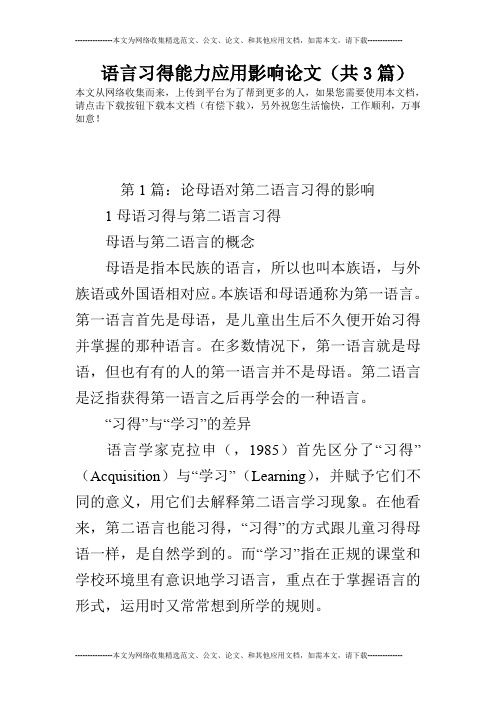
语言习得能力应用影响论文(共3篇)本文从网络收集而来,上传到平台为了帮到更多的人,如果您需要使用本文档,请点击下载按钮下载本文档(有偿下载),另外祝您生活愉快,工作顺利,万事如意!第1篇:论母语对第二语言习得的影响1母语习得与第二语言习得母语与第二语言的概念母语是指本民族的语言,所以也叫本族语,与外族语或外国语相对应。
本族语和母语通称为第一语言。
第一语言首先是母语,是儿童出生后不久便开始习得并掌握的那种语言。
在多数情况下,第一语言就是母语,但也有有的人的第一语言并不是母语。
第二语言是泛指获得第一语言之后再学会的一种语言。
“习得”与“学习”的差异语言学家克拉申(,1985)首先区分了“习得”(Acquisition)与“学习”(Learning),并赋予它们不同的意义,用它们去解释第二语言学习现象。
在他看来,第二语言也能习得,“习得”的方式跟儿童习得母语一样,是自然学到的。
而“学习”指在正规的课堂和学校环境里有意识地学习语言,重点在于掌握语言的形式,运用时又常常想到所学的规则。
2母语对第二语言习得的双重作用母语对第二语言习得的影响主要是通过语言迁移来实现的,所谓语言迁移,主要是指母语的习惯转移。
这种母语习惯转移,可能是积极的,也可能是消极的。
当母语规则与目标语规则相同时,迁移可为积极的;当母语与目标语之间出现差异时,迁移多为消极的。
正向迁移是指对学习有利的语言习惯转移,在母语与第二语言有相同的形式时会出现这种情况。
母语与目标语的相似之处容易为学习者掌握。
负向迁移也叫干扰,就是由于套用母语知识学习第二语言而带来的负作用,对新语言的学习,母语起到了干扰作用。
总之,语言的正迁移对学习外语起到积极作用,负迁移起消极作用。
母语对第二语言习得的干扰作用母语在语音层面上的负迁移英汉语分属于两个不同的语系,其差别较之属于同一语系的语言来说又要大些。
按照对比分析学派的观点,这将会导致学习中的母语负迁移。
中国学生学习英语时汉语负迁移在语音方面的表现主要如下。
第二语言习得理论与实践
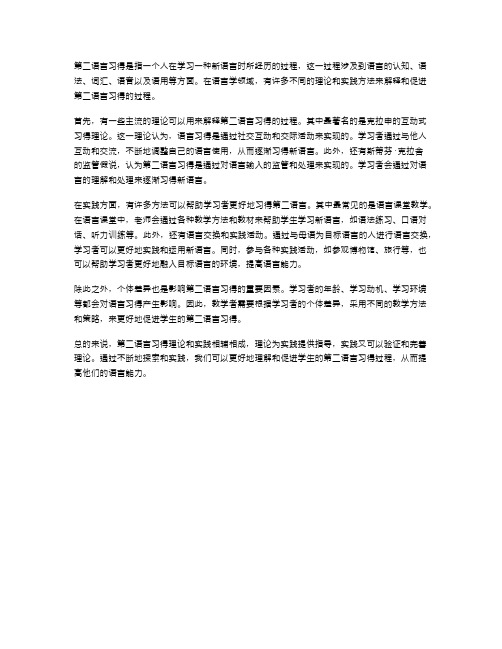
第二语言习得是指一个人在学习一种新语言时所经历的过程,这一过程涉及到语言的认知、语法、词汇、语音以及语用等方面。
在语言学领域,有许多不同的理论和实践方法来解释和促进第二语言习得的过程。
首先,有一些主流的理论可以用来解释第二语言习得的过程。
其中最著名的是克拉申的互动式习得理论。
这一理论认为,语言习得是通过社交互动和交际活动来实现的。
学习者通过与他人互动和交流,不断地调整自己的语言使用,从而逐渐习得新语言。
此外,还有斯蒂芬·克拉舍
的监管假说,认为第二语言习得是通过对语言输入的监管和处理来实现的。
学习者会通过对语言的理解和处理来逐渐习得新语言。
在实践方面,有许多方法可以帮助学习者更好地习得第二语言。
其中最常见的是语言课堂教学。
在语言课堂中,老师会通过各种教学方法和教材来帮助学生学习新语言,如语法练习、口语对话、听力训练等。
此外,还有语言交换和实践活动。
通过与母语为目标语言的人进行语言交换,学习者可以更好地实践和运用新语言。
同时,参与各种实践活动,如参观博物馆、旅行等,也可以帮助学习者更好地融入目标语言的环境,提高语言能力。
除此之外,个体差异也是影响第二语言习得的重要因素。
学习者的年龄、学习动机、学习环境等都会对语言习得产生影响。
因此,教学者需要根据学习者的个体差异,采用不同的教学方法和策略,来更好地促进学生的第二语言习得。
总的来说,第二语言习得理论和实践相辅相成,理论为实践提供指导,实践又可以验证和完善理论。
通过不断地探索和实践,我们可以更好地理解和促进学生的第二语言习得过程,从而提高他们的语言能力。
第二语言习得论文
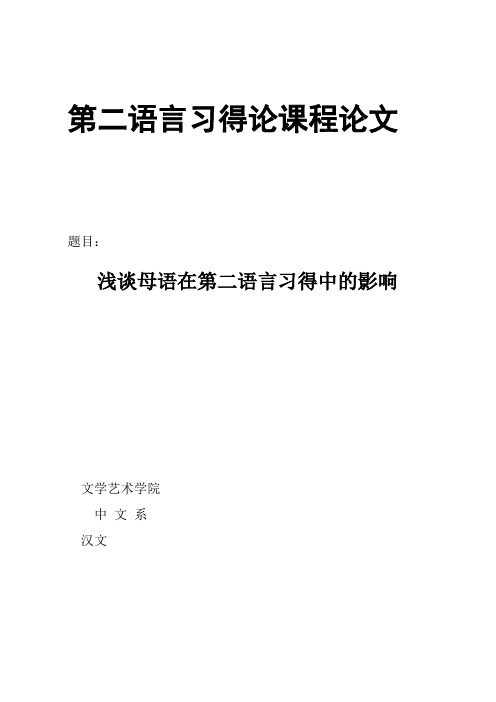
第二语言习得论课程论文题目:浅谈母语在第二语言习得中的影响文学艺术学院中文系汉文浅谈母语在第二语言习得中的影响我们都知道,任何事情都有两面性,有利也有弊,有积极的影响,也总会有消极的影响,母语在第二语言习得中的作用也是这样的。
这也就是学术界对于母语在第二语言习得中的影响一直存在着争议的原因。
大多数学者认为母语在第二语言习得中起着阻碍和干扰的作用,结合我们在第二语言学习中遇到的困难,的确证实了母语对第二语言习得中的干扰性和阻碍性。
但同时,我们不能因为母语在第二语言习得中的这些消极的阻碍和干扰就全盘的否定其在第二语言习得中的积极推动作用。
母语对第二语言习得的消极作用是非常明显的,这主要体现在以下的几个方面。
第一,在第二语言学习的过程中,我们经常受我们母语中的思维习惯的影响来表达和运用所学的语言知识,这就使得我们经常将第二语言母语化的倾向,为我们的学习带来消极的影响。
这主要体现在不同的文化背景下,我们的思维习惯不尽相同,很多我们习以为常的习惯和方式等,在另一文化背景下则显得不能接受和匪夷所思。
以英语和汉语的问候和寒暄习惯来说,中国人打招呼习惯问“你吃了吗?”,习惯谈论稍稍涉及隐私的诸如家庭,经历等话题,而英国人多谈论天气之类的话题,家庭经历等被视为禁忌。
这样就给我们的第二语言学习带来消极的影响,若是想将这种消极的影响降低,就必然增加了我们学习的负担。
当然,这种阻碍和影响也迫使我们拓展了知识,所以,也有它积极的一面。
第二,母语中的语法规和习惯也给第二语言的习得带来了一定的阻碍和影响。
这一影响在第二语言的学习中的消极影响最显而易见,也最为严重。
语法的规则和习惯很容易给第二语言的学习带来理解上的困惑和偏差,还是拿汉语和英语为例。
汉语和英语的语法在总体上非常相近,都是主谓宾等的基本语序,然而,汉语除了最基本的语法外,还经常有变式,如名词动用,宾语前置等,而且,汉语区分音节,这样就给以英语为母语的学习者在学习汉语时带来了诸多困难和阻碍;再拿英语来说,除了和我们的母语汉语较为相近的内容外,英语还有各种从句,是我们从未接触的,若是再用我们的母语进行学习的迁移,就会在理解上造成巨大的偏差,同样给第二语言的学习带来了阻碍。
二语习得论文

二语习得论文二语习得文化适应性对学习的影响现如今文化交流的日益频繁,使文化适应成为当下文化研究中的重要主题之一。
而了解文化适应性又是探讨学生二语习得成果的重要指标, 也是社会语言学研究的一个重要方面。
它涉及到二语习得者对目标语文化心理适应能力, 还涉及到他们语言习得动机的促进。
如何将文化适应同教学和学习有机结的合起来, 是提高他们学习积极性和效率的有效途径。
一. 文化适应的内涵“文化适应”一词,一般公认是美国的鲍威尔( John W.Powell) 最早提出的,他于1883 年将其定义为“低等文化模仿先进文化过程中所造成的心理变化”。
文化适应在两个不同的文化之间人们的交流中产生。
我们首先要了解什么是第二语言习得和文化适应。
“第二语言的学习是人们学习一种非母语语言的过程。
”第二语言的学习有两种主要的方式:第一种被称为“综合性学习动机”,即学习者可以跟第二语言的使用人群进行交流;另一种叫“手段动机”,即学习者的学习是为了某种实际的目的。
因此,语言学习的益处显而易见,语言是一种交流工具,学习一门语言可以在很大程度上减少学习者和第二语言适用人群的障碍,从而便于交流与合作。
所谓文化适应是指学习者与目的语社团的社会和心理的结合,因此学习者与目的语文化的社会距离与心理距离,就成了影响第二语言的主要原因。
二.文化适应的影响因素关于文化适应的影响因素,门登霍尔( M. E.Mendenhall) 与奥德多( G. Oddou) 认为,文化适应有四个维度的因素,即自我导向维度、他人导向维度、认识维度和“文化硬性”维度。
其中,自我导向维度指个体自信和精神健康的能力; 他人导向维度指个体与异质文化群体有效交流的能力和意愿; 认识维度指对于异质文化行为的正确归因能力和自身行为可能引起冲突的预测能力; 文化硬性维度指异质文化本身的开放度,这涉及到文化距离等因素。
在文化适应的情感因素方面,除个体好恶之外,较为显著的影响因素是社会支持。
2024年浅谈二语习得理论的应用途径

2024年浅谈二语习得理论的应用途径引言二语习得(Second Language Acquisition, SLA)是语言学习研究领域的一个重要分支,主要研究人们如何学习并掌握第二语言的过程和机制。
随着全球化的发展和多语言环境的普遍存在,二语习得理论在多个领域都展现出了其实践价值和应用前景。
本文将探讨二语习得理论在多个方面的应用途径,包括课堂教学法、网络学习资源、语言实践活动、沉浸式学习环境等。
课堂教学法二语习得理论为课堂教学提供了丰富的指导原则和方法。
其中,交际教学法和任务型教学法是两种广泛应用的教学法。
交际教学法强调通过真实情境中的交流活动来学习语言。
这种方法鼓励学习者在实际使用中体验语言,通过角色扮演、对话练习等活动提高语言的流利性和准确性。
任务型教学法则侧重于通过完成具有实际意义的任务来培养学习者的语言运用能力。
这种方法将语言学习与现实生活紧密联系起来,使学习者在解决问题的过程中自然而然地提升语言能力。
网络学习资源随着网络技术的发展,网络学习资源已成为二语习得的重要途径。
在线课程、语言学习网站和应用程序等网络资源为学习者提供了便捷、高效的学习方式。
这些资源通常具有互动性强的特点,如在线测试、语音识别和智能推荐等,能够帮助学习者在个性化、自主化的环境中进行有效学习。
同时,网络学习资源还可以让学习者随时随地进行学习,不受时间和地点的限制,极大地方便了学习过程。
语言实践活动二语习得理论认为,语言实践是提高语言能力的关键。
因此,参与各种语言实践活动对于二语习得至关重要。
语言实践活动包括语言交换、语言俱乐部、国际志愿服务等。
这些活动为学习者提供了与母语者交流的机会,有助于他们在实际应用中提高语言的流利性和准确性。
此外,这些活动还能培养学习者的跨文化交流能力,加深对不同文化的理解和尊重。
沉浸式学习环境沉浸式学习环境是近年来二语习得领域的一个热门话题。
通过创建类似目标语言国家的文化和生活环境,沉浸式学习环境能够帮助学习者更好地融入语言实践,提高语言学习效果。
第二语言习得研究论文

母语对第二语言习得的影响摘要:母语是影响二语习得最重要的因素之一。
二语习得领域的研究者针对母语与第二语言习得之间的关系进行了深入研究,并提出了诸多理论学说。
基于已往的研究成果,本文拟运用语言迁移理论对此问题进行较全面的论述,旨在探讨母语对二语习得的影响,构建克服母语干扰理论框架。
关键字:第二语言习得、迁移、母语、语言迁移第二语言习得的过程和结果受到许多因素的影响。
母语是习得二语时最不容忽视和影响力最为显著的因素,许多研究者对母语与二语习得之间的关系进行了深入的研究,提出了各类相似学说。
本文探讨母语对二语习得的影响,为减少母语迁移对外语学习的阻碍提出切合实际的策略。
一、母语习得与第二语言习得(一)母语与第二语言的概念母语是指本民族的语言,所以也叫本族语,与外族语或外国语相对应。
本族语和母语通称为第一语言。
第二语言是泛指获得第一语言之后再学会的一种语言。
当然。
它又分为在目的语环境中学习的第一语言以外的语言,这叫习得第二语言。
在非目的语的环境中学习第一语言或母语之外的其他语言,则称为外语。
目前,在二语习得领域,多数研究者对外语和习得第二语言不加区分,统称第二语言。
(二)习得”与“学习”的差异克拉申认为,流利的第二语言是运用“习得的”语言系统的结果,只有语言习得才能直接促进第二语言能力的发展,才是人们运用语言时的生产机制。
而有意识地“学习来的”语言知识只能用于监控,而不能视为语言能力本身的一部分。
克拉申对“习得”与“学习”的区分是有一定道理的,但是二者绝对不是相互独立,毫不相干的两个过程,事实上这两种过程会交织在一起,无法截然分开。
“学习”的知识经过一段时间也可有像“习得”来的知识那样处在“不自觉”的状态,低估了这种知识,就等于否定在课堂情景下学习第二语言的可能性。
二、母语在二语习得中作用的研究现状截止到现在,已经有许多来自海内外的专家学者做试验,收集数据,目的是为了探究母语在二语习得中到底起多大的作用。
第二语言习得理论在英语教学中的应用

第二语言习得理论在英语教学中的应用随着全球化和国际化的发展,英语作为全世界使用最广泛的语言之一,在中国的教育、经济、文化等各个领域都扮演着重要的角色。
因此,英语学习已成为现代化教育的重要内容之一。
然而,对于普通学生来说,学好英语并非易事。
在这个过程中,第二语言习得理论成为了英语教学师生们的重要研究对象。
第二语言习得理论,其目的是帮助人们更好地学习和掌握第二语言(L2)。
而对于英语教学而言,第二语言习得理论更是可以为英语教育者提供更好的指导方法和灵感。
基于这种理念,本文旨在探讨第二语言习得理论在英语教学中的应用。
第一部分:第二语言习得理论第二语言习得理论是指人们在学习第二语言时的内在心理过程。
研究发现,人们习得第二语言存在着与习得母语不同的心理机制和规律。
具体来说,第二语言习得理论主要包括以下几个方面:1、语言输入语言输入是指人们学习语言的过程中所接受到的信息。
语言输入对于第二语言习得的作用是至关重要的。
语言输入质量的高低会对第二语言习得产生积极或消极的影响。
与母语习得不同,第二语言习得需要有大量的相关语言输入。
同时,这种语言输入需要针对语言学习者的语言水平和语言需求等问题进行定制和设计。
2、暴露度和密度暴露度和密度是指第二语言习得者与第二语言接触的频率和持续时间。
如果学习者的暴露度和密度越高,那么其第二语言习得的速度和效果也就越高。
3、语言输出语言输出是指说话和写作等语言表达方式。
语言输出对于第二语言习得也有很大的作用。
通过自由的语言输出,第二语言习得者可以更好地巩固学习的知识和技能,并且可以更好地理解和应用学习过程中的错误。
4、语言规则和语言结构的学习语言规则和语言结构的学习是指学习者在习得第二语言的时候所需要掌握的基本语言规则和语言结构,包括句子结构、语法、单词运用等等。
这是学习者在语言习得过程中必须重点学习的内容。
第二部分:第二语言习得理论在英语教学中的应用1、提供优质的教育资源提供优质的教育资源是英语教学的重要组成部分。
第二语言习得的理论与实践

第二语言习得的理论与实践第二语言习得(Second Language Acquisition,SLA)是指个体在母语习得之后,对另一种语言的学习和掌握过程。
这一领域涉及心理学、语言学、社会学等多个学科,旨在探究学习者如何在不同环境下有效地习得第二语言。
本文将介绍几种主流的第二语言习得理论,并探讨其在实际教学中的应用。
行为主义理论行为主义理论认为语言习得是一个习惯形成的过程。
通过刺激-反应机制,学习者对环境中的语言输入做出反应,并逐渐形成正确的语言习惯。
在教学中,这一理论强调模仿和重复练习,如语音训练和句型操练,以帮助学生形成正确的语言习惯。
认知理论认知理论强调学习者内部心理活动的作用,认为语言习得是一个信息处理的过程。
学习者需要对输入的语言材料进行加工、储存和提取。
在教学上,认知理论倡导有意义的学习任务和策略训练,鼓励学生通过解决问题来学习语言。
社会文化理论社会文化理论认为语言习得是社会互动和文化参与的结果。
学习者在与他人的交流中逐步掌握语言。
这一理论强调社会环境的重要性,提倡使用真实的语言材料和情境,鼓励学生通过合作学习和角色扮演等活动提高语言能力。
输入假说输入假说由斯蒂芬·克拉申提出,主张学习者通过理解略高于当前水平的语言输入(i+1)来习得语言。
在教学实践中,这意味着教师应提供足够多的可理解输入,如听力和阅读材料,以促进学生的语言发展。
输出假说输出假说由梅瑞尔·斯温提出,强调语言产出在语言习得中的作用。
学习者通过尝试使用目标语言来检验自己的假设,并通过反馈进行调整。
教学中,鼓励学生积极参与口语和写作练习,以提高他们的语言能力。
应用实例在实际教学中,教师可以根据不同的理论设计教学活动。
例如,根据行为主义理论,可以设计模仿练习;根据认知理论,可以设置问题解决任务;根据社会文化理论,可以组织小组讨论;根据输入假说,可以提供大量的阅读材料;根据输出假说,可以安排演讲和写作作业。
二语习得的论文
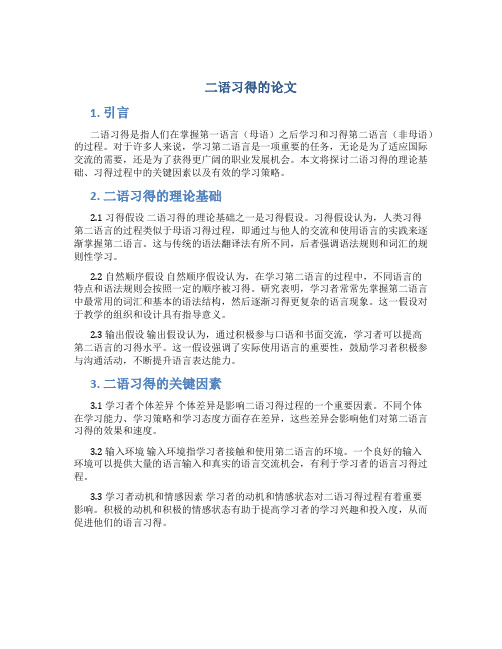
二语习得的论文1. 引言二语习得是指人们在掌握第一语言(母语)之后学习和习得第二语言(非母语)的过程。
对于许多人来说,学习第二语言是一项重要的任务,无论是为了适应国际交流的需要,还是为了获得更广阔的职业发展机会。
本文将探讨二语习得的理论基础、习得过程中的关键因素以及有效的学习策略。
2. 二语习得的理论基础2.1 习得假设二语习得的理论基础之一是习得假设。
习得假设认为,人类习得第二语言的过程类似于母语习得过程,即通过与他人的交流和使用语言的实践来逐渐掌握第二语言。
这与传统的语法翻译法有所不同,后者强调语法规则和词汇的规则性学习。
2.2 自然顺序假设自然顺序假设认为,在学习第二语言的过程中,不同语言的特点和语法规则会按照一定的顺序被习得。
研究表明,学习者常常先掌握第二语言中最常用的词汇和基本的语法结构,然后逐渐习得更复杂的语言现象。
这一假设对于教学的组织和设计具有指导意义。
2.3 输出假设输出假设认为,通过积极参与口语和书面交流,学习者可以提高第二语言的习得水平。
这一假设强调了实际使用语言的重要性,鼓励学习者积极参与沟通活动,不断提升语言表达能力。
3. 二语习得的关键因素3.1 学习者个体差异个体差异是影响二语习得过程的一个重要因素。
不同个体在学习能力、学习策略和学习态度方面存在差异,这些差异会影响他们对第二语言习得的效果和速度。
3.2 输入环境输入环境指学习者接触和使用第二语言的环境。
一个良好的输入环境可以提供大量的语言输入和真实的语言交流机会,有利于学习者的语言习得过程。
3.3 学习者动机和情感因素学习者的动机和情感状态对二语习得过程有着重要影响。
积极的动机和积极的情感状态有助于提高学习者的学习兴趣和投入度,从而促进他们的语言习得。
4. 有效的学习策略4.1 意识化学习策略意识化学习策略是指通过有意识地关注语言的形式和结构,来提高语言习得效果的策略。
学习者可以通过分析语言现象、记忆规则和词汇等方式,加深对语言的理解和掌握。
第二语言习得理论在英语教学中的应用

第二语言习得理论在英语教学中的应用在当今全球化的时代,英语作为一门国际通用语言,其重要性日益凸显。
对于英语学习者来说,如何有效地掌握这门语言是一个关键问题。
而第二语言习得理论为英语教学提供了重要的指导和启示。
第二语言习得理论是一个复杂而多元化的领域,涵盖了众多的学者和观点。
其中,克拉申的“输入假说”和“情感过滤假说”具有广泛的影响力。
克拉申认为,学习者需要接触大量的可理解输入,即略高于其现有语言水平的语言材料,才能实现语言习得。
同时,情感因素如学习动机、自信心和焦虑程度等,会对语言输入的吸收产生过滤作用。
如果学习者的情感状态不佳,即使有足够的输入,也难以有效地习得语言。
在英语教学中,应用“输入假说”意味着教师要为学生提供丰富、真实且有趣的英语语言材料。
例如,通过播放英语电影、歌曲、展示英语原版书籍和杂志等方式,让学生接触到多样化的语言表达和语境。
同时,教师在课堂上的讲解和互动也应使用自然流畅的英语,为学生营造一个沉浸式的语言环境。
为了确保输入的可理解性,教师可以运用肢体语言、图片、实例等手段帮助学生理解新的语言知识。
“情感过滤假说”则提醒教师要关注学生的情感状态,努力营造一个轻松、支持和鼓励的学习氛围。
对于那些学习积极性高、自信心强的学生,教师要给予充分的肯定和挑战,推动他们不断进步;而对于那些容易焦虑、缺乏自信的学生,教师则需要更多的耐心和鼓励,帮助他们克服心理障碍。
比如,在课堂上可以设计一些小组活动,让学生在合作中互相支持和鼓励,减轻个体的压力。
同时,教师对于学生的错误应采取宽容和引导的态度,避免过度批评导致学生产生恐惧和抵触情绪。
除了克拉申的理论,互动理论也为英语教学提供了有价值的视角。
互动理论强调语言习得是在学习者与他人的交流互动中发生的。
通过与他人的交流,学习者能够获得语言输入,并根据对方的反馈调整自己的语言输出,从而不断提高语言能力。
在教学实践中,教师可以组织各种形式的课堂互动活动,如对话练习、角色扮演、小组讨论等。
二语习得理论在汉语教学中的应用
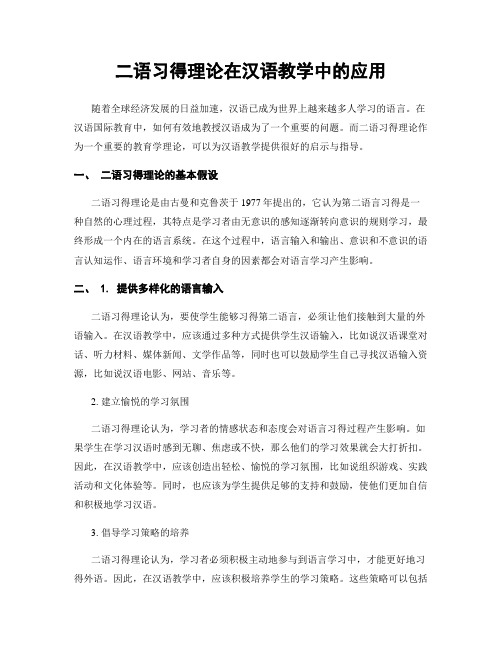
二语习得理论在汉语教学中的应用随着全球经济发展的日益加速,汉语已成为世界上越来越多人学习的语言。
在汉语国际教育中,如何有效地教授汉语成为了一个重要的问题。
而二语习得理论作为一个重要的教育学理论,可以为汉语教学提供很好的启示与指导。
一、二语习得理论的基本假设二语习得理论是由古曼和克鲁茨于1977年提出的,它认为第二语言习得是一种自然的心理过程,其特点是学习者由无意识的感知逐渐转向意识的规则学习,最终形成一个内在的语言系统。
在这个过程中,语言输入和输出、意识和不意识的语言认知运作、语言环境和学习者自身的因素都会对语言学习产生影响。
二、 1. 提供多样化的语言输入二语习得理论认为,要使学生能够习得第二语言,必须让他们接触到大量的外语输入。
在汉语教学中,应该通过多种方式提供学生汉语输入,比如说汉语课堂对话、听力材料、媒体新闻、文学作品等,同时也可以鼓励学生自己寻找汉语输入资源,比如说汉语电影、网站、音乐等。
2. 建立愉悦的学习氛围二语习得理论认为,学习者的情感状态和态度会对语言习得过程产生影响。
如果学生在学习汉语时感到无聊、焦虑或不快,那么他们的学习效果就会大打折扣。
因此,在汉语教学中,应该创造出轻松、愉悦的学习氛围,比如说组织游戏、实践活动和文化体验等。
同时,也应该为学生提供足够的支持和鼓励,使他们更加自信和积极地学习汉语。
3. 倡导学习策略的培养二语习得理论认为,学习者必须积极主动地参与到语言学习中,才能更好地习得外语。
因此,在汉语教学中,应该积极培养学生的学习策略。
这些策略可以包括制定学习计划、注意汉字拼音的学习、利用语感进行口语训练、寻找语音、语法、词汇差异等间接证据进行学习等等。
通过这些策略的应用,学习者可以更加自主地学习汉语,提高汉语的习得效率。
4. 坚持语境导向的教学二语习得理论认为,在语言习得过程中,学习者需要学会将语言知识应用到语境中,才能真正掌握语言规则。
因此,在汉语教学中,要坚持语境导向的教学,让学生通过实际应用汉语的场景来学习语言知识。
第二语言教学论文赏析八篇

第二语言教学论文赏析八篇其次语言教学论文第1篇[关键词]语言;SIA;日语一、前言近些年来,随着我国改革开放的力度日益加强,我国与世界各国都建立了友好关系,包括和日本。
中日两国在政治、经济和文化等领域开展了全面沟通和合作。
在这种形势背景下,日语学习开头受到重视。
越来越多的英语专业学习者在选择二外时开头青睐日语。
然而,许多同学一开头兴致勃勃地选择日语作为二外,但经过一段时间的学习之后,面对日语语速较快、词汇繁多、语法结构简单的状况,开头消失爱好递减的现象。
这极不利于同学学习日语语言。
那么,应当如何利用英语专业同学的语言优势,调动同学的学习乐观性,采纳合理的二外日语教学方法来提高日语学习效率呢?这是当前二外日语教学必需讨论的重要内容。
本文以其次语言习得理论为切入点,探讨其日语教学中的应用,具有肯定的现实意义和指导意义。
二、其次语言习得理论的内涵其次语言习得(second language acquisition),简称SIA,是指人们在获得母语(第一语言)的基础上习得另一种或几种语言的过程。
我们生活在一个人类占统治地位的星球上,构成人类的不同人群讲着不同的语言,如汉语、英语、法语、俄语、西班牙语、阿拉伯语、德语和日语等。
为了和讲不同语言的人们进行交际,人们除了要学习本民族的语言(母语或第一语言)外,还需要学习与把握其他的语言。
这种学习与把握其他语言的过程,就叫做其次语言的习得。
其次语言习得讨论一般认为是从1967年科德(S.P.Corder)发表其经典论文“同学偏误的意义”(The Significance of Learner’s Errors)和1972年塞林克(selinker)发表的题为“中介语”(Interlanguage)的论文开头的。
此后,其次语言习得讨论得到了蓬勃进展,各种讨论理论不断更新,讨论队伍日益扩大,讨论手段也正朝着科学化迈进。
其次语言习得理论的消失,使得人们不再用静止的、机械的、片面的眼光去看待语言学习,而是把语言学习看成是心理机制、认知行为、社会环境、文化历史等多种因素综合作用的过程。
第二语言语用习得研究对外语教学的启示论文

第二语言语用习得研究对外语教学的启示论文关于第二语言语用习得研究对外语教学的启示论文论文关键词:语用习得;丈化意识;外语教学论文摘要:二语习得过程中的语用能力的发展问题正受到研究者的关注。
二语语用能力的发展受多种因素的影响,如语法能力,语言迁移以及学习者地位和社会交往等。
本文探讨了在课堂环境下二语语用能力的培养,涉及到课堂语用知识的可教性和语用精入,重视个体的发展和文化意识的培养,目的在于帮助学习者在语言交际中强化语用意识,提高语言能力。
一、引言20世纪80年代Canale&Swain的研究成果(第二语言教学与测试中交际模式的理论基础》标志着二语语用习得研究新领域的开始。
在这个研究领域中,Ellis(1994)在《第二语言习得研究》一书中总结了当时的语用习得研究,指出了在语用能力发展过程中的三个重要因素,即学习者的语言能力,语用迁移以及学习者的地位和社会交往。
在Ellis的研究之后,Kasper&Rose(1999,2001)等将二语习得和语用学研究紧密结合起来,关注二语习得研究过程中的认知特性,从理论和方法两方面就二语/外语语用习得和语用能力发展做出新的系统研究成果。
国内学者如何自然等(2003)也提出了外语教学的语用路向,即外语教学中的语用学方法论。
随着语用习得研究的深人,语用能力的培养已成为语言教学的焦点之一。
本文希望通过对语用习得的探讨重新审视外语教学的视角,在教学过程中重视对学生语用能力的培养,强化语用意识,提高学生的语言交际能力。
二、影响二语语用能力发展的因素(一)语法因素Ellis(1994)认为学习者的语法水平是其语用能力发展的基础,很多研究者也赞同这一观点。
但是也有研究者对此观点提出质疑,认为语法水平高未必语用能力就强。
持这种观点的研究者认为,有的学习者虽然了解某种语言形式,但是却不能在真实语境下恰当地使用这种语言形式。
Bardovi-HarligandDornyei(1998)和Niezgoda&Rover(转自Kasper,2001)对EFL和ESL两类学习者的语用和语法认知程度以及两者的相关性试验研究发现,ESL学生具有更强的语用意识,认为语用错误比语法错误更严重,而EFL学生正相反;通过对语言水平较高的学习者语用能力的检测,发现试验的结果始终是一致的:语法能力和语用能力并非正相关,即语法能力高并不一定保证语用能力高。
第二语言习得论文
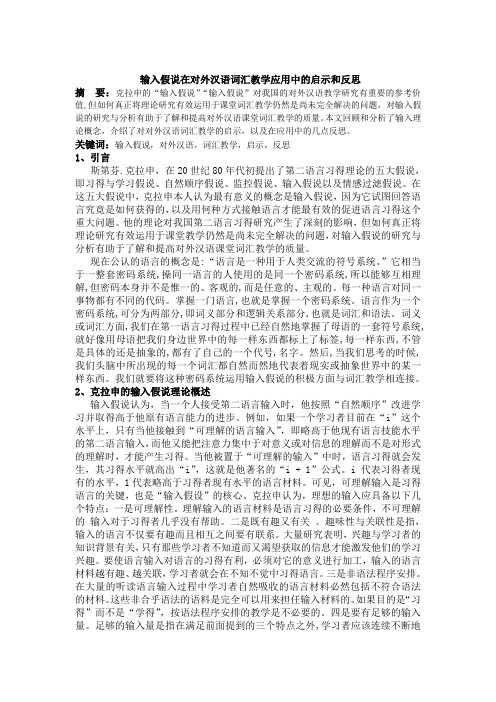
输入假说在对外汉语词汇教学应用中的启示和反思摘要:克拉申的“输入假说”“输入假说”对我国的对外汉语教学研究有重要的参考价值,但如何真正将理论研究有效运用于课堂词汇教学仍然是尚未完全解决的问题,对输入假说的研究与分析有助于了解和提高对外汉语课堂词汇教学的质量。
本文回顾和分析了输入理论概念,介绍了对对外汉语词汇教学的启示,以及在应用中的几点反思。
关键词:输入假说,对外汉语,词汇教学,启示,反思1、引言斯第芬.克拉申,在20世纪80年代初提出了第二语言习得理论的五大假说,即习得与学习假说、自然顺序假说、监控假说、输入假说以及情感过滤假说。
在这五大假说中,克拉申本人认为最有意义的概念是输入假说,因为它试图回答语言究竟是如何获得的,以及用何种方式接触语言才能最有效的促进语言习得这个重大问题。
他的理论对我国第二语言习得研究产生了深刻的影响,但如何真正将理论研究有效运用于课堂教学仍然是尚未完全解决的问题,对输入假说的研究与分析有助于了解和提高对外汉语课堂词汇教学的质量。
现在公认的语言的概念是:“语言是一种用于人类交流的符号系统。
”它相当于一整套密码系统,操同一语言的人使用的是同一个密码系统,所以能够互相理解,但密码本身并不是惟一的、客观的,而是任意的、主观的。
每一种语言对同一事物都有不同的代码。
掌握一门语言,也就是掌握一个密码系统。
语言作为一个密码系统,可分为两部分,即词义部分和逻辑关系部分,也就是词汇和语法。
词义或词汇方面,我们在第一语言习得过程中已经自然地掌握了母语的一套符号系统,就好像用母语把我们身边世界中的每一样东西都标上了标签,每一样东西,不管是具体的还是抽象的,都有了自己的一个代号,名字。
然后,当我们思考的时候,我们头脑中所出现的每一个词汇都自然而然地代表着现实或抽象世界中的某一样东西。
我们就要将这种密码系统运用输入假说的积极方面与词汇教学相连接。
2、克拉申的输入假说理论概述输入假说认为,当一个人接受第二语言输入时,他按照“自然顺序”改进学习并取得高于他原有语言能力的进步。
第二语言习得理论在中学英语教育中的应用与评价

第二语言习得理论在中学英语教育中的应用与评价引言:随着全球化的加速发展,英语已成为世界上最重要的第二语言之一。
在中国的中学教育中,英语的地位愈加重要。
如何更好地教授英语,让学生掌握语言技能,一直是教育界关心的焦点。
在英语教育中,第二语言习得理论的应用促进了学生的语言发展,值得我们深入研究和评价。
一、第二语言习得理论的概述第二语言习得理论是指研究人类在成年之后学习第二语言的过程和规律的学科。
它从认知、社会和语言角度出发,探讨了学习者在获得第二语言能力的过程中所经历的各个阶段和难点。
常见的第二语言习得理论包括行为主义理论、认知理论和社会交互理论。
行为主义理论认为语言是通过刺激和反馈进行习得的,强调重复和记忆的作用。
认知理论则强调通过思维和内部心理过程来获得语言能力,注重学习者的主动参与和自主学习。
社会交互理论则强调人际互动对语言发展的重要性,认为语言的使用和学习是社会交往的产物。
二、第二语言习得理论在中学英语教育中的应用1. 创设真实情境:在中学英语教育中,通过创设真实情境,使学生置身于语言应用的场景中,能够增强学生的语感和语境理解能力。
比如,教师可以组织角色扮演活动,让学生扮演不同的角色,进行真实对话。
这样的教学方式能够让学生更好地理解和运用英语,提高他们的口语表达能力。
2. 引导自主学习:第二语言习得理论强调学习者的主动参与和自主学习。
在中学英语教育中,教师可以通过启发式问题、交流小组等方式,激发学生的学习兴趣和动力,培养学生的自主学习能力。
同时,通过鼓励学生利用多种学习资源,如课外阅读、多媒体等,加强他们的语言输入和输出。
3. 提供即时反馈和纠正:根据行为主义理论,及时的反馈和纠正对于语言习得至关重要。
在中学英语教育中,教师应及时给予学生的作业和表达进行评价,并提供具体的改进建议。
同时,教师还可以引导学生互相纠错,促进他们在交流中发现问题并加以纠正。
4. 促进学生的互动与合作:社会交互理论强调人际互动对语言发展的重要性。
- 1、下载文档前请自行甄别文档内容的完整性,平台不提供额外的编辑、内容补充、找答案等附加服务。
- 2、"仅部分预览"的文档,不可在线预览部分如存在完整性等问题,可反馈申请退款(可完整预览的文档不适用该条件!)。
- 3、如文档侵犯您的权益,请联系客服反馈,我们会尽快为您处理(人工客服工作时间:9:00-18:30)。
第二语言习得理论及应用语言是人类区别于其他动物的重要标志之一。
人借助于语言进行交际,交流思想,达到互相了解,组成人类社会生活;人还借助于语言,进行思维活动,揭露事物的本质和规律,创造人类的物质文明和精神文明,然而语言的作用还远不止如此。
如果我们探讨外语学习心理的主要目的是教好一门语言,是帮助学习者学会用这门外语进行交际,那么,我们应该懂得什么是语言。
Brown,H列出语言的八个特点,它们是:1.语言是系统,可能是一个生成系统。
2.语言是一种任意的符号。
3.这些符号是声音符号,但也可能是视觉符号。
4.符号有约定俗成的意义。
5.语言用于交际。
6.语言在言语社团或言语文化中发生作用。
7.语言实质上为人类所有,虽有可能不限于人类。
8.所有的人以大致相同的方式习得语言。
语言和语言学习具有普遍的特征。
”①第二语言习得理论作为一门独立的学科形成于60年代末,70年代初。
然而,人们对第二语言习得产生兴趣和开展研究的历史却要早得多。
50年代初,Weinreich就在它的著作《语言的联系》中讨论了母语和第二语言两种语言体系的关系,并提出了一个重要的概念“干扰”。
这种干扰可以发生在语音、语法、语义三个层面上。
1957年,美国语言学家Robert Lado发表了具有很大影响的著作《跨文化语言学》。
从某种意义上来说,Lado的著作是对Weinreich理论的补充。
Lado的结论是:“对第二语言学习者来说,学习中最为困难的地方就是第二语言与第一语言差别最大的地方。
因此,外语教学的重点应该集中在两种语言的差别上。
”②60年代在语言和语言习得的研究领域发生了一场大争论,这场争论被不少人称为一场“革命”。
在这场“革命”中,由Bloomfield提出的结构主义和由Skinner在语言习得研究领域提出的极端的行为主义理论对语言本质和语言习得的基本观点都受到了Chomsky的猛烈攻击。
①Brown,R.1973.Afirst langusge:The Early Stages.Harmondsworth: PenguinBooks.Page89.②Lado,R.1957.Linguistics across Cultures: Applied Linguistics for Language Teachers. Miehigan:University of Miehigan. Page 53.争论过后,人们开始认识到一个事实,那就是语言是一种特殊的体系,要了解这一体系的发展过程,我们不能单纯的从外界的因素中去寻找答案,它有它自己的内在发展规律。
1972年,美国语言学家Lany Selinker 发表了著名的”中介语”一文。
”中介语”一词很快就被广泛接受,用来指第二语言学习者独立的语言体系。
“中介语(即学习者语言)的某些构成成分既不是来自于母语,也不是来自于目标语。
学习者在接触到的语言材料基础上构建自己的语言结构,并通过归纳和推论产生了中介语语言体系,这个语言体系既有别于学习者的母语体系,也有别于他们所学习的目标语体系。
中介语的主要特征之一是具有过渡性,他处于不断的变化之中。
也就是说,学习者在逐步增加对目标语了解的过程中,实际上在大脑中构建了一系列由简单到复杂的学习者语法,也就是中介语语法。
”③语言的起源与思维并非同时。
从种系发展与个体发展来看,语言发展中存在非思维阶段,思维发展中存在非语言阶段。
但是语言和思维一经产生后却又常常互相作用和影响,互相推进和制约。
在很多情况下,语言和思维直接联系,但也确实存在语言与思维分离的生理和心理现象。
在语言和思维这对矛盾中,思维起主导的作用,语言能力的发展不能先于认知能力的发展,但是认知能力本身还不足以解释语言发展,因为语言有其本身的发展规律;语言从属于思维,它决定不了思维,但却可以影响人们的某些思维方式。
第二语言习得的教学的终极目标就是在学习者的头脑中,固定一种语言的思维模式。
例如英语教学,老师们提到最多的一句话就是要学会用英语来思考。
那么相对应的,如果对外汉语的老师,能够做到让受教者学会用中文思考的方式,那么就是一位相当成功的老师。
以前我们专业叫做对外汉语硕士,现在叫做汉语国际教育硕士。
从名称上来看,对外汉语,分开了内与外,而汉语国际教育硕士,没有分内外,将汉语教育作为一种国际定位,比以前的名称更大气,更有分量。
与之对应的,对外汉语教学也被称作了汉语作为第二语言教学。
这样的称呼,更专业,也更看重了第二语言习得理论的影响。
汉语这门语言,有一定的特殊性,它不像英语等语言,是以表音为主。
汉语是一门以表意为主的语言。
语素是语言的最小单位,也是构词的最小单位。
单音节语素在语素中占绝大多数。
在口头上,一个单音节语素指的是一个带声词的音节; 在书面上是汉字,过去常有说词是由字构成的,那是因为一个汉字绝大多数情况下代表一个语素。
科③Selinker,L.1972.Inter language. International Review of Applied Linguistics,10209-31学的说法应该是词是由语素构成的。
汉字作为汉语书面语言的基本单位,是一种语素文字。
语素是语音和语义的最小结合体,是语言的原材料,是不能单独使用的纯粹的备用单位。
汉字和语素有相当强的对应关系,90%的汉字对应于汉语的一个语素,一般一个字代表一个音节,既是书写单位又是意义单位,构成一个认知单元;而且没有语法上的形态变化。
汉语的词大多由单音节“语素”构成。
单音节语素在构词上有神奇的力量,单音节语素写出来是一个字,所以我们计算单音节语素的数量可以以字的数量来计,常用的大概有三千多个,次常用的又有三千多个。
六千多个单音节语素,以一定的语法结构组合,可以构成的词当在几万,常用词也会有上万个。
我们说汉语有极强的构词能力,这是由语素这个较小的单位到词这个较大的单位来分析的构词的特点。
那么从词再到语素,汉语词汇相应的也具有非常强的离散性。
也就是说,词汇的意义往往可以分散构成词汇的语素的意义。
在这样的情况下,往往给我们教学带来了一定的难度。
除了汉语的听说系统以外,还有认读的汉字系统。
也就是说,两个系统都教好了,才是完成了对外汉汉语的教学使命。
那么在对外汉语教学中,如何才能更好地让第二语言习得者受到良好的教育,首道更好的课堂教学效果呢?我觉得,在对外汉语教学中实施适当的课堂活动,可以增进学生的学习兴趣,提高教学效果。
这种方法特别是在初级汉语教学中,效果更为明显。
留学生虽然来自于不同的国家,但是总体上来看,好奇心较强。
因为他们大多数都有一定的目的性,不是强制性的学习。
所以针对他们的好奇心,可以在课堂上开展各类活动,引起他们的兴趣,吸引他们的注意力。
从心理学的角度来讲,他们的活动动机以直接的近景性动机为主。
这种动机主要来自对内容或活动本身的直接兴趣。
课堂活动的趣味性特点恰好能促进近景性动机的形成,并使之不断地得到巩固和支持。
首先,初级汉语的内容属于起步阶段,学习一门课程,在起步阶段培养兴趣是非常关键的一步。
正如孔子所说“知之者不如好之者,好之者不如乐知者”。
而培养兴趣的最好方法,莫过于在游戏和活动中学习。
其次,初级汉语的课程是以零起点的标准来设计的,大部分都是基础内容,而且与生活密切相关。
这样的内容安排在课堂活动中,不但容易学习,而且印象深刻。
对于一门新的语言,仅仅看字面的内容是远远不够的。
它包括了文化底蕴、眼神交流、身体语言等等各方面的内容。
在课堂活动中,教师能够有目的地训练学生听、说、读、写的技能,并培养他们初步运用表达、说服等方式与人交流以及正确获取信息等方面的交际能力。
比方说,角色扮演能够培养学生的表达能力;小型比赛可以培养良好的竞争意识和集体主义精神。
通过小组合作,加强团结互助;通过遵循一定的游戏规则,培养一定的自律习惯;同时,通过对其他不同文化背景的同学对照,从而发现自己的不足,逐步意识到自我的修正及完善个性的迫切性,并努力为交际积累素材。
开展课堂活动,必须有一个充分的准备,这个准备是做好游戏的前提,只有在课前做好了各方面的充分准备,课堂游戏活动才能顺利开展。
这个准备包括多方面:道具、游戏环节的设计、知识点与游戏的结合等等都是要在游戏之前考虑好的问题。
道具的准备要少而精,代表性强;游戏的环节设计必须紧凑而流畅;知识点与游戏的结合要自然而紧密。
只有将以上几个方面都做到,才能说是为课堂游戏活动做好了充分的准备。
进行游戏活动,需要大脑兴奋起来。
初级班的学生刚刚接触中文,具有极大的兴趣,做游戏的时候容易投入,这是保证课堂游戏顺利进行的有利条件。
但是这一点有利有弊。
如果学生过于投入,容易在游戏中过于注重结果,就会发生政治或者闹情绪。
这就要求教师能够善于引导学生,使课堂活动不偏离初衷。
还有一种情况,学生进行课堂活动的时候,因为好玩或者激动,有时候会忘记自己身在课堂,开始嘻嘻哈哈。
这种情况下,也需要教师及时引导,使课堂教学不偏离正轨。
开展课堂游戏活动的时候,对于学生优秀的表现应该及时给予相应的表扬与鼓励。
在游戏中,鼓励的方式更为灵活多样,语言鼓励,手势鼓励,眼神鼓励,等等。
及时到位的鼓励不但可以推动游戏的顺利开展,更能够调动学生参与的积极性。
要开展好课堂游戏活动,必须有良好的组织能力。
在课堂上要有良好的观察能力及掌控能力。
进行课堂游戏活动不是单方面的传授,而是双方面的互动。
因此,对老师的组织能力提出了更高的要求。
所以,要做好课堂游戏活动,必须努力提高自身的组织能力。
在进行课堂游戏活动时,要讲解游戏规则,发出指令,及时鼓励,适当启发,这些都要求老师的语言清晰易懂,简短明确。
在准确语言的基础上,学会用手势等肢体语言来与学生互动。
在课堂游戏活动中,老师要能够运用自己的观察力,来掌握学生的反应,适时调整游戏活动的策略。
掌握学生的动态在课堂游戏的开展中是很重要的一环。
在开展游戏活动的过程中,会发生的情况可能有很多,就算是做了再充分的准备,还是可能会有意想不到的情况发生。
因此老师应该努力提高自身的应变能力,来应对突发情况。
参考书目:《对外汉语教学概论》商务印书馆2009 赵金铭《对外汉语教学示范教案》北京师范大学出版社2009 张和生《教育学》华东师范大学出版社1999 邵宏杰《心理学》华东师范大学出版社1999 韩永昌Brumfit,C.1994.The linguist and the language teaehing profession: In Baraseh and James (eds).1994.Brown,R.1973.Afirst langusge:The Early Stages.Harmondsworth: PenguinBooksLado,R.1957.Linguistics across Cultures: Applied Linguistics for Language Teachers. Miehigan:University of MiehiganSelinker,L.1972.Inter language. International Review of Applied Linguistics。
